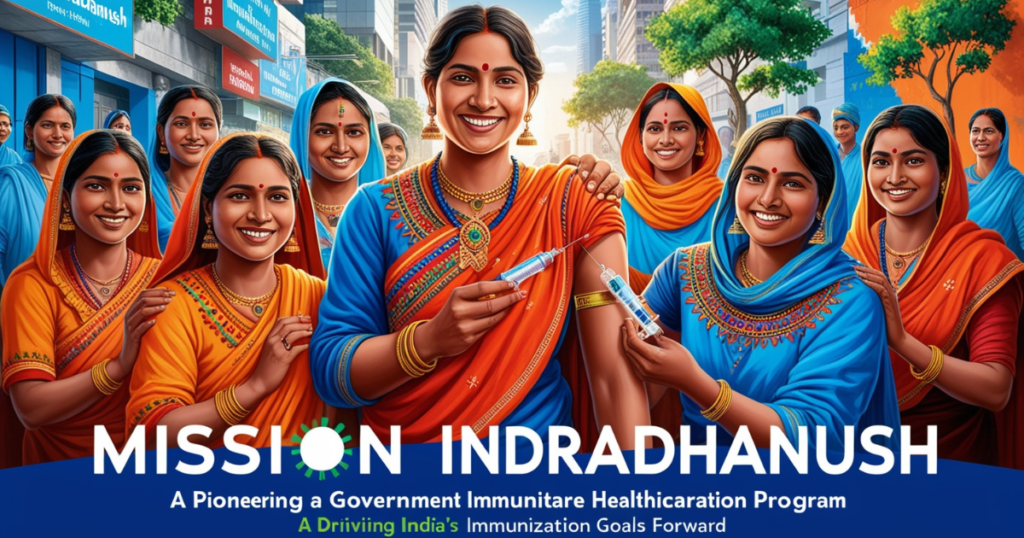Introduction to Mission Indradhanush
Mission Indradhanush is a flagship initiative launched by the Government of India to achieve full immunization coverage for children and pregnant women. This ambitious program aims to boost immunization rates and protect children against deadly diseases, significantly reducing infant mortality rates.

Objectives of Mission Indradhanush
The primary goal of Mission Indradhanush is to ensure that 90% of children under the age of two years and all pregnant women receive complete immunization against vaccine-preventable diseases (VPDs). The mission particularly targets underserved and high-risk areas where immunization coverage is low.
Key Features of Mission Indradhanush
- Targeted Approach: The mission focuses on 201 high-priority districts that account for nearly 50% of the unvaccinated or partially vaccinated children in the country.
- Special Immunization Drive: It includes intensive campaigns conducted over seven working days every month, separate from routine immunization efforts.
- Coverage of Multiple Vaccines: The program administers vaccines for diseases such as diphtheria, pertussis, tetanus (DPT), poliovirus, measles, hepatitis B, tuberculosis (BCG), and meningitis.
- Involvement of Multiple Stakeholders: A collaborative effort involving state governments, district administrations, community health workers, and international organizations like WHO and UNICEF.
- Identification of Left-Out Areas: Special emphasis is placed on urban slums, tribal areas, and conflict-affected zones, where access to healthcare is limited.
Phases of Mission Indradhanush
Since its inception, Mission Indradhanush has undergone multiple phases to enhance its outreach and impact:
Phase 1 (2014-2015)
- Launched on December 25, 2014, targeting 201 high-focus districts with low immunization coverage.
- Aimed to immunize 26 million children and pregnant women.
Phase 2 (2015-2016)
- Extended to 352 additional districts to accelerate immunization coverage.
- Introduced focused interventions in areas with significant dropout rates.
Phase 3 (2016-2017)
- Further intensified in 216 districts based on the results of previous phases.
- Special monitoring mechanisms were introduced for real-time tracking of immunization progress.
Phase 4 (2017-2018)
- Expanded to 190 districts where immunization rates remained below 60%.
- Greater engagement of NGOs and community healthcare workers.
Intensified Mission Indradhanush (IMI) (2017)
- Launched to rapidly scale up immunization in 121 districts and urban areas.
- Focused on hard-to-reach areas and high-risk populations.
- Aim: To achieve 90% full immunization coverage by December 2018.
IMI 2.0 (2019-2020)
- A renewed push to cover any remaining gaps in immunization.
- Focus on districts with less than 70% immunization coverage.
IMI 3.0 (2021)
- Launched during the COVID-19 pandemic to sustain immunization efforts.
- Targeted 250 districts and urban areas where immunization had been disrupted due to pandemic-related challenges.
IMI 4.0 (2022)
- Aimed at saturating full immunization coverage in all remaining pockets of unvaccinated populations.
- Special emphasis on migratory and nomadic communities.
Impact and Achievements
Increase in Immunization Coverage
- Before the launch of Mission Indradhanush, India’s immunization coverage was 65%.
- Post the implementation of the initiative, the coverage rose to 85% in many districts.
Reduction in Vaccine-Preventable Diseases
- The mission has significantly reduced the incidence of diseases such as measles, diphtheria, and polio.
- Neonatal tetanus elimination was achieved across the country.
Enhanced Awareness and Community Participation
- Through aggressive awareness campaigns, millions of parents have been educated about the importance of immunization.
- Local health workers (ASHA, ANM, and Anganwadi workers) have played a pivotal role in identifying and vaccinating children.
Challenges and the Way Forward
Challenges Faced
- Geographical Barriers: Reaching remote and conflict-prone areas remains a challenge.
- Vaccine Hesitancy: Cultural beliefs and misinformation lead to reluctance in vaccine acceptance.
- Dropout Rates: Ensuring follow-up doses remains a concern in certain regions.
- Logistics and Cold Chain Management: Effective storage and transportation of vaccines require continuous monitoring.
Future Strategies
- Strengthening Routine Immunization: Integrating Mission Indradhanush with regular immunization programs.
- Leveraging Technology: Using AI and real-time tracking systems for efficient vaccine distribution.
- Expanding Public-Private Partnerships: Collaborating with corporates and NGOs to enhance reach.
- Combating Misinformation: Increasing community-based awareness campaigns to counter vaccine hesitancy.
Conclusion
Mission Indradhanush has been a game-changer in India’s healthcare landscape. By ensuring universal immunization, it has significantly reduced child mortality and improved public health. The continued expansion and intensification of the mission are crucial to achieving a disease-free future for India.